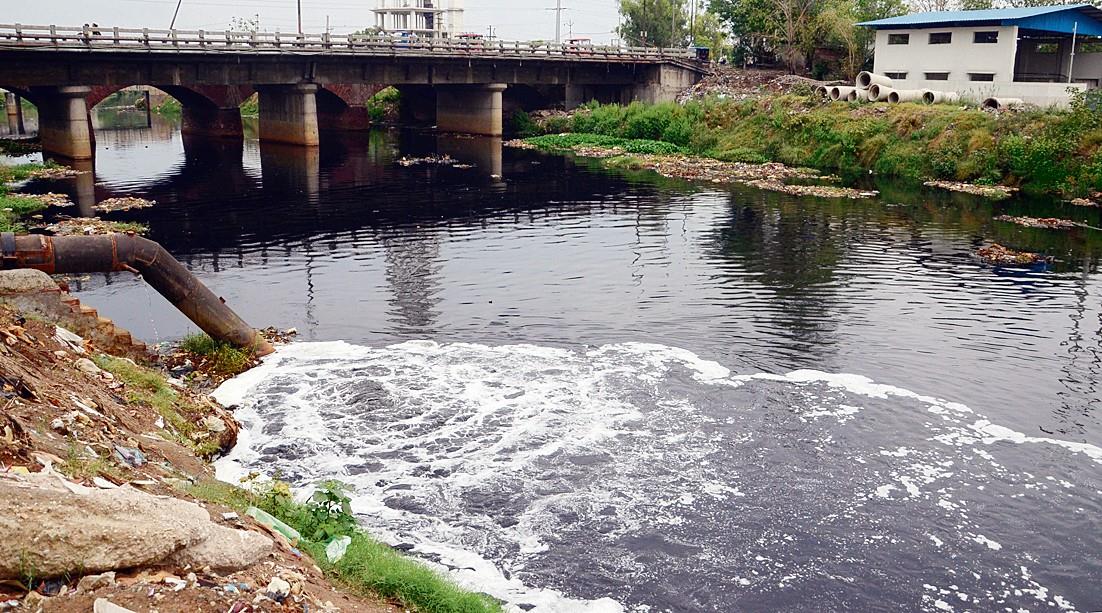
Effluents discharge into Buddha Nullah. HIMANSHU MAHAJAN
Nitin Jain
Ludhiana, May 2
Despite the tragic death of 11 persons, including a family of five, at Giaspura in Ludhiana due to poisonous gas, the flow of polluted effluents from domestic, industrial and dairy units continues unabated into sewer lines and open nullahs in different parts of the industrial capital of the state, posing a major threat to public life.
The Giaspura tragedy seems to be another chemical poisoning accident if the impunity with which environmental laws are violated with unscientific and illegal dumping of domestic, industrial and dairy waste or chemicals in Ludhiana is any indication.
A visit to various parts of the city on Tuesday revealed that effluents generated from domestic, industrial and dairy units were flowing without any check into sewer lines and open nullahs, most of which further fall into Buddha Nullah, a highly polluted seasonal tributary of the Sutlej.

Though the Municipal Corporation (MC) and the Punjab Pollution Control Board (PPCB) authorities claim to have taken numerous steps to check the flow of pollutants into the sewer lines and open nullahs, the ground situation belies all such claims.
“Two new STPs of 285 MLD capacity, upgrade of four STPs and MPS with 418 MLD capacity, three dyeing cluster CETPs of 105 MLD, two ETPs of 6 MLD, six intermediate pumping stations and 11,310-metre-long interceptor pipelines to stop direct discharge of wastewater into Buddha Nullah are among the major steps taken to ensure that only treated waste or fresh storm water may flow into the sewer lines and open nullahs that further meet the Sutlej tributary,” MC Commissioner Shena Aggarwal said.
The PPCB had recently sealed dyeing machines at 22 industrial units for excess discharge of effluents.
The dyeing machines were sealed after checking the actual discharge, which was found far higher than the PPCB’s permissible limits.
A recent study had revealed that a whopping 765 MLD wastewater generated mostly in the municipal limits of Ludhiana had polluted Buddha Nullah. While domestic effluent remained the major contributor, dairy waste and industrial effluents had made it one of the most polluted nullahs.
The study conducted by the state government had shown that 625 MLD of domestic effluent, 134 MLD of industrial emission and 6 MLD of dairy waste was flowing into the Sutlej tributary, turning it into one of the most polluted water bodies.
To plug the effluent discharge and ensure that only treated domestic wastewater or fresh or stormwater flows into Buddha Nullah, the rejuvenation project had been planned to treat 703 MLD of domestic effluent, 137 MLD of industrial emission and 6 MLD of dairy waste discharge, with a total treatment capacity of 846 MLD against the estimated wastewater generation of 765 MLD.
Roping in experts from the Council of Scientific and Industrial Research (CSIR) for ascertaining the reason behind the Giaspura gas leak tragedy, the MC has also issued an advisory for residents to ensure their safety.
They have been advised to install water traps (p-trap) at the sewer connection point of buildings/ houses to stop the inflow of gases, if any, to the houses from the sewer lines.
The MC Commissioner said a detailed investigation was being undertaken by the MC and the PPCB. “Samples have been collected from the incident site and we are in contact with the Director, CSIR-Indian Institute of Petroleum, Dr Anjan Ray, to ascertain the reason behind the incident and formation of hydrogen sulphide, which is suspected to have led to the incident,” she said.
Civic body, PPCB claims fall flat
- A visit to various parts of the city revealed that effluents generated from domestic, industrial and dairy units were flowing into sewer lines and open nullahs
- Though the MC and the PPCB claim to have taken steps to check the flow of pollutants, the ground situation belies such claims
Join Whatsapp Channel of The Tribune for latest updates.




























